Exam 1
1/137
Earn XP
Description and Tags
Quiz 1 is related to unit 1 content. This includes: developmental context, research methods, research applications, classification assessment and diagnosis, and early development slides
Name | Mastery | Learn | Test | Matching | Spaced |
|---|
No study sessions yet.
138 Terms
Define Abnormal (in terms of psychopathology)
This behavior can be “defined” as any behavior that is creating problems in a person’s life or is disruptive to other people
Can abnormality be described within a vacuum?
It cannot be defined within an isolated condition. Abnormal is defined by a structure of a society that has certain expectations, and within social relationships with varying levels of tolerance.
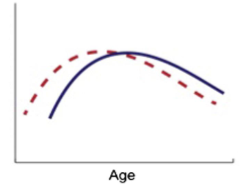
What abnormal developmental trajectory is defined by the following graph? (where blue is “typical development” and red “atypical”)
Precocious - compared to typical development, this development is characterized by earlier/faster than typically developing children. These individuals developmental milestones and skills show up at younger ages than expected.
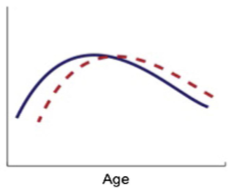
What abnormal developmental trajectory is defined by the following graph? (where blue is “typical development” and red “atypical”)
Delayed - compared to typical development, this development is characterized by later/slower than typically developing children. These individuals take longer than expected to reach certain developmental milestones.
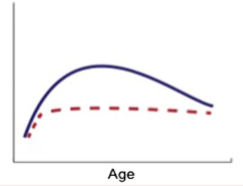
What abnormal developmental trajectory is defined by the following graph? (where blue is “typical development” and red “atypical”)
Halted - compared to typical development, this development is characterized by a normal trajectory that stops or plateaus at a certain stage. These individuals may start acquiring skills, but fail to progress beyond a certain point.
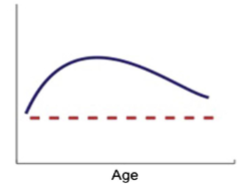
What abnormal developmental trajectory is defined by the following graph? (where blue is “typical development” and red “atypical”)
Failure to mature - compared to typical development, this is characterized by stunted or incomplete development, where the individual does not achieve expected developmental milestones. There is a significant gap between these individuals and what is considered “atypical”.
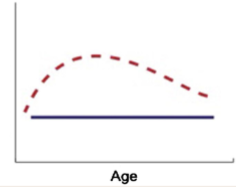
What abnormal developmental trajectory is defined by the following graph? (where red is “atypical”)
Ectopic - compared to typical development, this development is characterized by deviations from the typical development patterns entirely, often leading to unusual inconsistent, or unpredictable growth in certain areas. This may involve regression, uneven skill acquisition, or completely atypical patterns of growth.
What is an example of a Precocious development?
A child who begins speaking full sentences much earlier than their peers.
What is an example of Delayed development?
A child who begins walking or talking much later than the average age.
What is an example of Halted Development?
A child who begins to speak but then stops acquiring new language skills, remaining at a certain, lower level of speech development.
What is an Example of Failure to Mature?
A person who remains at a child's cognitive level well into adulthood.
What is an example of Ectopic Development?
A child who shows uneven cognitive development, excelling in some areas while being significantly delayed in others, such as advanced math skills but impaired social interactions.
What are the 4Ds for Assessing Psychopathology?
Deviate, Distress, Dysfunction, and Disproportionate
What questions are we asking when we are concerned with a behavioral deviation?
Does this behavior deviate from societal and developmental norms?
What questions are we asking when we are concerned with distress?
Does this behavior cause personal distress?
What questions are we asking when we are concerned with dysfunction?
Is the behavior maladaptive in a way that interferes with daily life to cause dysfunction?
What questions are we asking when we are concerned with disproportionate behavior?
Is the reaction/behavior disproportionate to what is typically expected?
A child is in distress when his mother leaves and cries until she returns again. He refuses to sleep without his mother nearby, and he struggles with enuresis (wetting the bed) every night.
What diagnosis would you apply?
Developmental Stage Consideration - the child’s distress and enuresis might be age-appropriate, especially in early childhood.
Attachment Patterns - could be a sign of anxious attachment. This behavior is typical for children who have difficulty feeling safe without their primary caregiver. More observation is needed to determine if this is a persistent pattern.
Emotional and Psychological Well-Being - the child might be experiencing situational anxiety due to environmental stressors
Physical and Medical Factors - enuresis can have multiple causes that extend beyond psychological disorder, such as underlying urinary tract infection or simple stress.
A child is in distress when his mother leaves and cries until she returns again. He refuses to sleep without his mother nearby, and he struggles with enuresis (wetting the bed) every night.
What other information do you need to make a diagnosis?
Child’s Age and Developmental Stage
Duration and Frequency of Behaviors
Triggers and Context of Behaviors
Family Dynamics
Social Environment
Medical History and Physical Health
What are the 6 Paradigms of child psychopathology?
Big - Biological = caused by child’s biology
Brave - Behavioral = Caused by a child’s environment
Children - Cognitive = caused by cognitive factors
Play - Psychoanalytic = caused by unconscious forces within child
Happy - Humanistic = caused by conditions of worth
Drums- Diathesis/Stress = caused by biology and environment
What is the effects of observers?
Effects of Observers - refers to the variability in how mental health disorders are identified and reported, which can lead to different estimates of how many children suffer from mental health disorders.
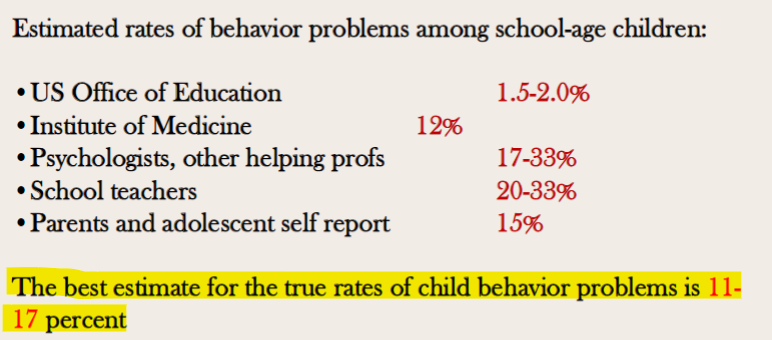
What does the following image tell us about the effects of observers?
Observer bias - cultural/personal beliefs may influence how an observer interprets a child’s behavior
Assessment Tools and Criteria - different organizations or studies use different diagnostic criteria (DSM-5 vs ICD-11) or screening tools for identifying disorders.
Context/Settings - context in which a child’s behaviors are observed (school vs home) can influence the likelihood of identifying a problem.
What are 2 hypotheses that we use to predict future child development?
Continuity Hypothesis
discontinuity Hypothesis
What is the continuity hypothesis in child development?
Development is gradual and cumulative, with early behaviors building into later behaviors. This hypothesis suggest that what behaviors you develop as a child follow you into adulthood
What is the discontinuity hypothesis in child development?
Development that occurs in distinctive stages, with qualitative shifts (sudden leaps) in abilities. This hypothesis suggest that children are able to overcome maladaptive behaviors in adulthood.
What are transitory and persistent behaviors
These behaviors refer to how long a behavior lasts and its stability over time
What are transitory behaviors?
Behaviors that are temporary and tend to change or disappear over time. These behaviors may arise in response to specific situations, developmental phases or temporary stressors.
What are some examples of transitory behaviors that we see in children?
Social withdrawal (not extreme forms)
nail-biting
sleep disturbances
specific fears and phobia
What are persistent behaviors?
Behaviors that are long-lasting and remain consistent over time. These behaviors often indicate more stable patterns and may require intervention if they are maladaptive
What are some examples of persistent behaviors that we see in children?
Self-confidence
intellectual capacity
clinical depression
obsessions and compulsions
autism
psychosis
Aggression and antisocial behaviors.
Define maladaptive
Behavior that interferes with an individual’s activities of daily living or ability to adjust to and participate in particular settings and participate in particular settings.
What are some barriers to predicting adult outcome from earlier, childhood behavior?
Developmental Changes
Environmental Changes (better OR worse)
Quality of measures
Behavior is multiply determined
Why are developmental changes a barrier to predicting adult outcome from earlier, childhood behaviors?
Children go through significant developmental changes that can alter their behaviors, abilities and even personality traits. So, a behavior that is typical or concerning in childhood may not persist or look the same in adulthood.
Why are environmental changes a barrier to predicting adult outcome from earlier, childhood behaviors?
Environmental changes can dramatically alter a child’s developmental path. 2 children living in the same environment can express different behaviors at adulthood.
Why are quality of measures a barrier to predicting adult outcome from earlier, childhood behaviors?
Ability to predict future behavior depends on the quality of the measures to assess child behavior. Poorly designed tools can result in incorrect information, making prediction less reliable.
Why is behavior being multiply determined a barrier to predicting adult outcome from earlier, childhood behaviors?
Multiple factors (e.g., biological, environmental, social and psychological) interact and influence how someone behaves. A child’s behavior at any particular moment can be a result of a complex web of causes. Thus, it becomes difficult to predict how these factors will influence individual’s behavior later in life.
Due to barriers in predicting adult outcomes, what type of predictions are the most accurate to make based on a child’s behaviors?
Short-term predictions are the most accurate given the information we have of a child’s behavior. We can make predictions about the child’s behavior but this is not applicable for future behavior.
Can group data predict individual outcomes?
Group data cannot predict individual outcomes. This generalization may be able to predict more immediate behaviors, but long-term outcomes cannot predict future behavior.
Why do we need to talk about research methods in a class about child psychopathology?
Understanding Evidence-Based Practice - in this field, interventions, treatment, and diagnoses should be based on empirical evidence rather than intuition or anecdotal experiences. Learning methods, helps students critically evaluate the quality and validity of studies.
Distinguishing Between Correlation and Causation - Without solid understanding of methods, it is easy to misinterpret correlations as causation. By learning how to distinguish the two, we can determine which factors actually contribute to psychopathology in children.
Ensuring Ethical and Valid Research Practices - This fields involves vulnerable populations, making it essential to conduct studies in an ethical and responsible manner. This includes obtaining consent (and assent), confidentiality, and minimizing harm to child participants.
What are the 4 types of research questions that child psychopathologist use to conduct research?
Descriptive questions, Difference questions, Relationship questions and Casual questions
Define descriptive questions
Are aimed at describing a group or type of individual
Example : “Prevalence and Characteristics of Autism Spectrum Disorder Among Children Aged 8 years - Autism and Developmental Disabilities Monitoring Network”
Define difference questions
Examine the differences between groups
Example title: “Biased Processing of Emotional Information, Girls at Risk for Depression” (comparing 2 groups)
Define relationship questions
Ask to what degree 2 or more factors covary (correlate)
Example title: “Relations among activity participation, friendship, and internalizing problems in children with autism spectrum disorder” (relationship btw two+ variables)
Define casual questions
try to identify a factor that causes a change in another factor.
Example title: “Cognitive-behavioral therapy for young children with anxiety disorders: Comparison of a Child + Parent condition versus a Parent Only Conditions” (manipulation of IV)
What are the 3 research paradigms that we use to conduct research in child psychopathology?
Experimental Research
Quasi-experimental Designs
Non-experimental Research
Define experimental research
In these studies, the independent variable is manipulated and its effect on the dependent variable is examined
Why is experimental research necessary but rare in clinical psychology?
Ethical Concerns - often involves vulnerable populations, making it ethically difficult to conduct experiments. For example, withholding effective treatment from a control group for the sake of the study can cause harm to participants (IRB violation). Furthermore, making a child “depress” is also causing harm.
Practical Challenges - many mental health concerns are deeply personal, contextual and variable, making it hard to create standardized, controlled conditions that experimental research requires.
What is another type of study that we conduct that let’s us to ask casual questions that isn’t experimental studies?
Intervention Studies
Define quasi-experimental research designs
When random assignment/manipulation of the IV is not possible, but you still want to examine the relationship of the IV to the DV. The groups being compared are often formed based on existing characteristics, rather than random assignment.
Define non-expeirmental research
Observation, analysis and description of phenomena — no manipulation of variables is involved
Define observational study
Observe a child’s behavior WITHOUT trying to intervene or change it. Measures and settings can be more or less structured depending on the research question.
A type of non-experimental study
Define case study
Collection of data on a single participant (or a very small set of participants) over time
Define qualitative research
The collection of data in non-numerical form (i.e., narratives or video) & descriptive analysis of that data without reducing it to numbers
What research paradigms allow us to answer causal questions
Only experimental research designs can answer causal questions.
What is an example of a quasi-experimental design?
Determining the effect of intellectual disability on interaction with peers.
What are some limitations of quasi-experimental research designs?
Cannot control other related variables that tend to naturally occur with intellectual disability (e.g., self-confidence)
correlation is not causation!
sometimes unclear which variable came first (chicken vs egg problem)
What are the 3 types of non-experimental designs
Qualitative non-experimental design, Case Study, and Observational studies
What are some benefits and limitations to a case study?
Benefits
Can gather rich, in-depth and complex information
Limitations
Very few people are being examined
Generalizability (as a result of small sample size, cannot be generalized to the population of interest)
Bias in reports - data collected from self-reports, personal interviews, etc., which can introduce subjective bias since participants can present information in a way that reflects their beliefs, rather than objective accounts.
When are case studies most appropriate or helpful to conduct?
studying rare or unique conditions (which can help provide treatment for the individual)
Exploring New or Emerging topics (like covid-19)
Providing rich, contextualized data (gives understanding for those suffering of rare diseases/afflictions)
What are some characteristics of a qualitative research?
Doesn’t need specific hypotheses
Purpose is to look at people’s behavior in its most naturally occurring forms
Helpful for generating hypotheses for future research
How do we answer developmental research questions in child psychopathology?
Developmental Framework - examines how a behavioral problem develops or changes over time
What are the two types of studies that allow us to use a developmental framework?
Longitudinal studies and Cross-Sectional study
Define longitudinal studies
Measures the same people at 2 or more time points (temporal studies)
What are the benefits of longitudinal studies?
Tracks developmental changes over time - allows researchers to observe developmental processes relating to aging
Establishes temporal relationships - can establish cause-and-effect relationships
Reduces Cohort Effects - observing same people eliminates effect of differences being related to experience being from a certain generation
What are the limitations of longitudinal studies?
Time-consuming and expensive
Attrition - participant dropout; may lead to bias if dropout is systematic
Risk of Changes in Measurement Tools - outdated
Subjects become “test-wise” - since subjects are being tested with relatively the same measures over time, they make become familiar with the testing process and may begin to anticipate task/questions

What developmental framework study is defined by the following structure:
Longitudinal studies
Define cross-sectional studies
Measures different people at 2 or more different developmental stages
What are the benefits of cross-sectional studies?
Quick and Cost-effective
Can obtain larger sample sizes
No Risk of Attrition - studies participants only at ONE time
Good for Identifying Behavioral Patterns as it relates to specific developmental stages.
Generalizability is more reliable
What are the limitations of cross-sectional studies?
Cannot Establish Causality - since these studies provide a snapshot at one point in time, we cannot determine cause-and-effect relationships
Cohort Effects - differences observed between groups may be due to cohort effects, which reflect differences in life experiences rather than true developmental changes
Limited information on Developmental Progression (temporal changes)
Snapshot View - is not able to capture dynamics of behaviors that tend to fluctuate
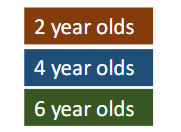
What developmental framework study is defined by the following structure:
cross-sectional studies
How do we answer treatment research questions in child psychopathology?
Treatment Framework - examine how a behavior problem changes in response to treatment
What are two types of treatment study designs that we use to assess the viability of a treatment?
Within Subjects Time-Series Designs and Between Subjects Experimental Designs
Define Within Subjects Time-Series Designs
These studies take repeated measures of child behavior pre-treatment, during treatment and post-treatment
Define Between Subjects Experimental Studies
These studies compare outcomes between two different groups of kids before and after treatment
What are some benefits of Within Subjects Time-Series Designs?
Less Participant Variability - Since the same individuals are being measured repeatedly, individual different between participants are controlled
Fewer Participants Needed - This design typically requires fewer participant since each participant serves as their own control
Tracks Changes Over Time - It allows researchers to observe how behaviors change in response to treatment over time
What are some limitations of Within Subject’s Time-Series Designs?
Carryover or “Practice” Effects - since participants are tested repeatedly, they may become “test-wise” or show improvements due to practice and not treatment.
Time-consuming and resource-intensive
Confounding Factors Over Time - external factors can influence the results during the time between measures
What are some benefits of Between Subjects Experimental Studies?
No carryover effects - since different groups are used, no concerns about practice/carryover effects influencing results
Clear Causal Inference - by comparing outcomes across distinct groups, research can make strong inferences about if treatment caused differences
What are some limitations of Between Subjects Experimental Studies?
Larger sample sizes required - this design requires large number of participants to achieve statistical power (reach significant conclusions)
Variability BETWEEN participants - individual differences between participants in experimental and control groups can confound results
Differences between developmental and treatment frames in child psychopathology
Developmental emphasizes understanding growth trajectories within the context of child’s age and stage, while treatment emphasizes symptom reduction and practical application of therapeutic methods

What type of treatment study design is being utilized in the following image?
Within subject time-series design
Why is it important to conduct an additional study or test well after the end of treatment in a within-subjects time series design?
It is important to determine if there are long-term effects of the treatment, if they are positive we want these effects to be long and negative effects to be short. Need to detect any relapse (development of new symptoms as well) or reversion after treatment.
Due to Between Subjects Experimental Studies having a limitation of sample size, what is the estimated amount of participants that is suggested to be in each group for your study to have sufficient statistical power?
N >= 30 participants per group
What ethical issues should we be concerned with in Child Clinical Research?
Informed Consent (and assent from children, which is a particular concern)
Deception
Potential Harm versus benefits (e.g., embarrassment or discomfort or withholding treatment from the controls)
What are the 3 steps of the research process?
developing a research question
Identifying Sample/Measurement Methods
Developing Research Design + Research protocol
Define standardization (regarding research creation)
A process that specifies a set of standards for a method of measurement, and these standards must be used consistently across different assessments of the SAME “construct” of interest
Define Research reliability
The degree to which a measurement obtained using the SAME TECHNIQUE is consistent.
What are the 2 types of reliability that we look out for when determining the effectiveness of our measures in research
Internal and Inter-rater reliabilities
Define internal reliability
Refers to consistency of results across items within a test or measurement tool that are designed to measure the same construct or behavior
ex. if a depression scale contains multiple questions about mood, IR would mean that the response to these questions are consistent with one another (i.e., someone who reports high in one area will report high in another)
define inter-rater reliability
Refers to consistency of measurements or ratings when different OBSERVERS assess the same phenomenon
ex. two clinical independently diagnose the same patient, the comparison of their combined diagnoses is IR
How do inter-rater and internal reliability differ?
Inter-rater focuses on agreement between different observers, whereas internal focuses on consistency of items with a singular test/measures
Define Research validity
The extent to which a study accurately measures with it intends to measure and can be generalized to broader context.
It assesses trustworthiness and applicability of the study findings.
What are the two types of validity that we look out for when we are creating measures for our experiement?
Internal and External Validity
Define internal validity. What is this validity mostly concerned with?
The degree to which a study can establish a cause-and-effect relationship between variables.
Free from confounding factors
observed effects are due to independent variable rather than uncontrolled variables
What are some threats to internal validity that may come up while conducting research?
Measurement Error - your items may not actually be measuring the construct
Confounds - certain items within a measure may be measuring the same things or measuring different things but relate to each other
Define external validity. What is this validity mostly concerned with?
The extent to which the results of a study can be generalized to other settings, populations or times beyond the specific conditions of the study.
What are some threats to external validity that may come up while conducting research?
Participant selection bias -sample is not representative of the larger population
Artificial lab settings - the “environment” is controlled and may not reflect the naturalistic world setting
What are the FOUR types of research designs?
Prospective studies, retrospective studies, ABA Reversal Designs and Multiple-baseline studies
define prospective studies
A research sample is identified and then followed over time, with data collected at specific time intervals
define retrospective studies
A sample of people is identified at the current time and asked to remember information from an earlier point in time
Define ABA Reversal Designs
A baseline of behavior is first taken (A), followed by an intervention phase (B), then a return-to-baseline phase during which the intervention is removed (A), and a final phase in which the intervention is reintroduced (B)
We expect that changes in behavior ONLY OCCUR during intervention stages (B), providing evidence that changes in behavior are due to the intervention.